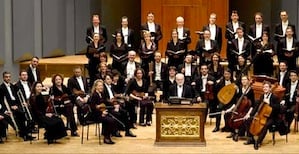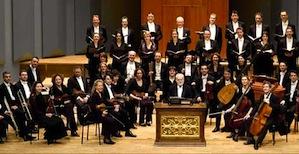
In most American cities, the privilege to hear Ton Koopman and the Amsterdam Baroque Choir and Orchestra perform Bach’s B-minor Mass would be a rare treat; for Bay Area audiences, including the one gathered by Cal Performances last Saturday, the privilege is almost routine. I can count at least eight productions of the work in the past year. This performance almost reached the level of such native Bay Area ensembles as the American Bach Soloists and the Philharmonia Baroque Orchestra — a very fine level, indeed.
I say “almost” because UC Berkeley’s drab, multipurpose Zellerbach Hall is entirely unsuited to this music and these performers. Builders choose their favorites, and in Zellerbach’s case, the favorites are amplified spoken word and dance. About five years ago, Cal Performances replaced the inadequate orchestral shell with an amplification system that still fails to do justice to early music. For example, in the famous horn solo accompanying the bass aria “Quoniam tu solus,” the bell of the horn faced the fabric wings. Without a shell to bounce its sound out into the hall, the horn was barely audible. Early-music singers, especially, depend on venues that easily reinforce and project their voices. Microphones pick up only the harsher edge of vocal tones, and loudspeakers do little to mimic the early reflections and reverberation of a naturally flattering acoustic. In addition, the 2,100-seat Zellerbach Hall is far too large for such ensembles, and the visual challenge to fill such a gargantuan space caused some singers to compensate with slight oversinging.
Once I was able to hear past this, the performance revealed all the aspects that make the Amsterdam Baroque Orchestra and Choir one of the best-regarded period-instrument ensembles in the world. This ensemble has recorded all of Bach’s cantatas, and I can forgive it for taking an often-formulaic approach to phrasing and articulation. It’s a formula that works. Koopman smiled throughout the performance, and I did not get the sense that he had an interpretive or a theological axe to grind. Details such as the shading-off in the strings in such phrases as “qui sedes” abounded without seeming heavy-handed.
The 26-voice professional choir was consistently excellent.
Soprano Teresa Wakim appeared equally at ease with the music, luxuriating in the beauty of her tone in a manner I might call operatic. The other soloists, Teresa Bartosz (alto), Tilman Lichdi (tenor), and Klaus Mertens (bass), were fine and well-matched. Lichdi had the best vocal presence in the hall, though he also sang with some odd vowel choices.
Mix-and-Match Architecture
Bass soloists in this Mass fall into two categories: those who sing the first bass aria better, and those who excel in the second baritone aria. Mertens fell into the latter category, offering forceful but attractive high-range singing in the “Quoniam.” Many music theorists have constructed elaborate diagrams to assert claims of the B-minor Mass’ large-scale structural design. I tend to view these designs with skepticism, when obvious evidence of planning (such as writing for consistent voice types) seems to have been ignored. My view of the Mass is that it’s more of a mix-and-match assemblage of exemplary movements, each capable of standing alone.
Bay Area period-instrument ensembles are on par with their more lavishly funded European counterparts.
The Sanctus is a case in point, because out of nowhere the chorus suddenly splits into two choirs; many performances include some awkward logistics to accommodate that split. The Amsterdam ensemble’s performance of the Sanctus was especially strong because of the decision to place the intermission between the Credo and the Sanctus, rather than after the Gloria. This also allowed the bass and soprano soloists to bow out for a bit. The rested voices shined in the Sanctus, a passage in which most performances show evidence of growing vocal fatigue.
The 26-voice professional choir was consistently excellent, as I expected. The basses tossed off the treacherous “Et iterum” passage without batting an eye, and the altos (a blend of countertenors and female altos) were consistently audible. I often had difficulty hearing the tenors, who usually tend to overbalance in this type of choir, but I suspect this was due to the limitations of Zellerbach’s acoustic. The only difference with professional American choirs was the pronunciation of Gheerie.
The most refreshing part of the concert was the reassurance I felt that Bay Area period-instrument ensembles are on par with their more lavishly funded European counterparts. In a preconcert interview in Classical Voice, Koopman referred to the challenge of American period-instrument groups: “the oboes would fly in from New York or Boston, the French horns from Chicago or Detroit. It’s a lot of work to get everybody together in one place.” This is not the case in Europe, where a few tickets on the Eurostar are enough to assemble a band. Luckily, the Bay Area has been able to routinely put together such groups. Let us hope this continues.

